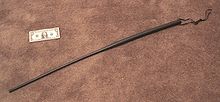- Sjambok
-
 A 3' (90 cm) plastic sjambok used by South African Police.
A 3' (90 cm) plastic sjambok used by South African Police.
The sjambok or litupa is the official heavy leather whip of South Africa, sometimes seen as synonymous with apartheid but actually much older and still used outside the official judiciary. It is traditionally made from an adult hippopotamus (or rhinoceros) hide, but is also commonly made out of plastic.
A strip of the animal's hide is cut and carved into a strip 3 to 5 feet (0.9 to 1.5 m) long, tapering from about 1 inch (25 mm) thick at the handle to about 3⁄8 in (9.5 mm) at the tip. This strip is then rolled (possibly between heavy metal plates) until reaching a tapered-cylindrical form. The resulting whip is both flexible and durable. A plastic version was made for the South African Police Service, and used for riot control.
The sjambok had a variety of uses, with the most obvious being cattle driving. While it may have been synonymous with discipline of people, it was heavily used by the Voortrekkers driving their oxen while migrating from the Cape of Good Hope. Even today, the sjambok is used by herdsmen to drive cattle. They are actually illegal to use in South Africa due to their historic connotations, though they are available illegally. The sjambok is also used today in South Africa by those who mete out discipline imposed by kangaroo courts.[1]
Other types
The name seems to have originated as cambuk in Indonesia, where it was the name of a wooden rod for punishing slaves, where it was possibly derived from the Persian "Chabouk" or "chabuk" . When Malayan slaves were imported to South Africa, the instrument and its name were imported with them, the material was changed to hide, and the name was finally incorporated into the Afrikaans, spelled as sambok.
The instrument is also known as imvubu (hippopotamus in Zulu), kiboko (hippopotamus in Swahili) and as mnigolo (hippopotamus in Malinké). In the Portuguese African colonies and Congo Free State it was called a chicotte, from the Portuguese word for whip. There it was sometimes rendered even more lacerating by adding nails.
In the Belgian Congo, the instrument was also known as fimbo and was used to force labour from local people through flogging, sometimes to death. The official tariff for punishment in this case was lowered in time from twenty strokes to eight, then (in 1949) six, and progressively four and two, until flogging was outlawed completely in 1955. In North Africa, particularly Egypt, the whip was called a kurbash, after the Arabic for whip. The term shaabuug is used in the Somali language; it can also refers to a generic leather whip.
References
- ^ Aitkenhead, Decca (2000-05-28). "Rough justice". The Guardian (London). http://observer.guardian.co.uk/life/story/0,,319167,00.html. Retrieved 2010-05-23.
External links
Categories:- Whips
- Police weapons
- African weapons
Wikimedia Foundation. 2010.
